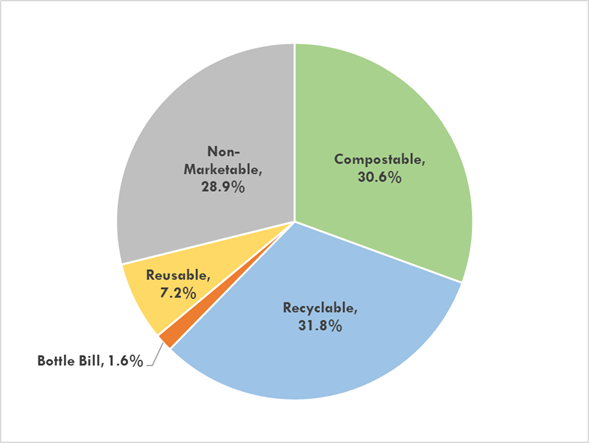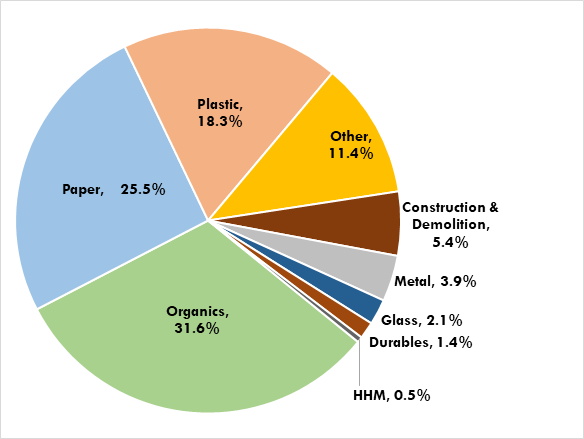Results from Iowa Waste Characterization Study Jump-Start Diversion Conversations
Research from the Iowa Department of Natural Resources shows potential for high diversion.

About 70 percent of landfilled waste in the State of Iowa could potentially be diverted through new and expanded reuse, recycling and composting programs. This was a finding of a waste characterization study looking at 61 items in the municipal solid waste stream generated by residential, commercial and industrial sectors.
“We looked at common recyclables from each sector and the estimated value of materials that could have been recovered in 2016. It was 60 million dollars, which was eye opening,” says Tom Anderson, executive officer of the Iowa Department of Natural Resources (DNR), which commissioned the study through SCS Engineers.
Anderson hopes these telling statistics and other findings will help local governments get ideas for boosting their diversion programs and outcomes. At the same time, he sees potential to open new commodities markets, expand existing ones and bring more jobs to Iowa. The state will convene a group of industry stakeholders to see how it can realize these gains.
One identified missed opportunity that will be a focus moving forward is compostable materials. Compostable paper, loose and packaged food waste and yard waste comprised 30.6 percent of the stream in 2017, up from 24 percent in 2011. In fact, overall food waste climbed to 22 percent in 2017, up from 13.3 percent in 2011.

Such fluctuations in volume are not unusual with most materials.
“I’ve been doing these waste characterization studies for 25 years, and back then, for instance, food waste was about 10 to 12 percent of the stream,” says Stacey Demers, project director at SCS Engineers. “But because of changes like recycling and light weighting of packaging, food waste is starting to become 20 to 25 percent. This doesn’t mean there is more food. Rather, a greater percentage of what’s destined for disposal is food. It’s becoming a heavy portion of trash. This is relevant because when you are looking at reducing, you focus on the dominant material, which is determined by weight.” The studies, which DNR has commissioned since the late 1990s, help inform the state as well as help local governments develop their own policies. Sometimes those local policies can impact a bigger picture, as appears to be the case with old corrugated cardboard (OCC).

“We have nearly cut in half landfilled OCC since our 2011 study,” says Anderson “I think a combination of local bans and programs has helped, as has the fact that industrial, institutional and commercial sectors are seeing there’s value in cardboard. They are recognizing it’s worth the effort to separate it.”
This month, Iowa City became the most recent of several local governments to ban OCC.
On the food waste front, Iowa plans to launch a website to educate residents and will later focus on a commercial website.
“Looking at these sectors separately is critical to assessing the landscape, as well as developing programs. With resident versus business, the approach would vary. Plus, you learn who is doing a good job and where improvement is needed,” says Brent Dieleman, a senior project professional at SCS Engineers.
DNR learned that food waste generated at hospitals’, schools’ and caterers’ cafeterias was surprisingly substantial. As a follow up, DNR performed an assessment that focused specifically on schools, even looking at trends in individual schools. It was then able to customize technical assistance for each school.
“Des Moines, for example, has a diverse population, so we printed picture food cards for students whose first language is not English,” says Anderson. “This effort let them know what was in [a dish] so they did not take and throw out what they would not eat if they weren’t sure what was in it.”
DNR will convene processors, municipalities and other stakeholders to look at existing programs as well as programs that could be started or modified to boost diversion of all materials.
The waste characterization study will be leveraged along with a rural hub and spoke study to help inform decisions.
“The hub and spoke study helped us understand recycling infrastructure and where material is going for processing,” says Anderson. “We will also look at capacity through this study. Do [facilities] need additional storage or additional processing equipment? From the waste characterization study, we will look at volume and type of materials.”
“Ultimately, by combining findings of both studies, we intend to see which materials to focus on, how to capture more and how to process them economically. And we will work to determine what partnerships could be put in place based on who has processing and storage capacities and available efficient transportation options.”
About the Author
You May Also Like




